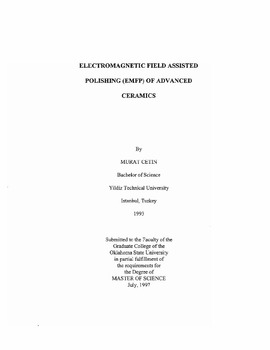| dc.description.abstract | Ceramic bearing balls offer significant advantages when compared to other bearing materials. Their superior perfonnance is due to special material properties such as their higher compressive strength, hardness, lower density, higher stifness, higher operating temperatures, and self lubricating properties. When these exceptional properties are combined, they provide longer service life and a reliable product. However, their high hardness together with brittleness is a big disadvantage in tenns of manufacturing. Merely extending the conventional manufacturing technique, namely V-Groove Lapping, for ceramics is a time consuming and not a cost effective process because of the higher hardness of these ceramic materials. Use of high polishing loads also produces surface defects which can reduce the strength and service life of the ceramic bearing balls. Expensive diamond abrasives and long processing times increase the manufacturing cost significantly. Magnetic float polishing (MFP) was introduced and employed to address and overcome some of the problems faced with conventional polishing. This technique was initially developed in Japan [Kato and Umehara]. It as a simple technique that utilizes magnetic fluid, commercially available sub-micron size abrasives, and a driving spindle. This technique requires magnetic field which can be generated either by pennanent magnets or an electromagnet, in order to utilize a magnetic buoyancy force of a non-magnetic body in a magnetic fluid. Magnetic float polishing technique involves little capital costs and can be incorporated with existing machine tools. The magnetic field required for the magnetic float polishing has been typically generated by using pennanent magnets. It has also been reported and proven in the literature that bearing balls can be finished to a desired manufacturing quality by using the permanent magnet polishing apparatus [Raghunandan and Komanduri, 1997 and Jiang and Komanduri, 1997]. As an alternative to the permanent magnet polishing apparatus, electromagnetic field assisted polishing apparatus was also designed and fabricated at Oklahoma State University. Initial design was developed by Dr. Shinmura of Japan at Oklahoma State University, and later altered to form a ring pole electromagnetic field assisted polishing apparatus. Eventhough, this new design showed promising results, it did not meet with the required finish requirements. In order to address this problem, a modified ring pole design was proposed and built as an alternative to the ring pole design. During the evaluation of this new design, FEM analysis was employed to compare and simulate the results with the ring pole design. Experimental studies were carried out using the modified ring pole design as well as the original ring pole design. The experimental studies serve to create the necessary data base for establishing optimum polishing conditions. Approximately 4.5 um/min material removal rate was accomplished when polishing silicon nitride workpiece material as compared to 2 um/min with the permanent magnet apparatus. Surface roughness (Ra) of 13 m was also observed. The average sphericity with the ring pole design was 0.45 um and with the modified ring pole design was 0.9 um. | |
